By Gregg Gillies -
Set Up: Area 30x20 divided into 4 rectangle areas (15x10). 4V4 + 4. See Diagram 1 below for the set up of the players. The attackers are the players in black. The defenders are in yellow. You can adjust the size based on your players age and skill level.
The Drill: The two black players in the middle (the central midfielders) can move in all four rectangles but must not occupy the same rectangle at the same time.
There is 1 defender per rectangle.
The players on the outside can move along the full length of their designated line.
Diagram 1
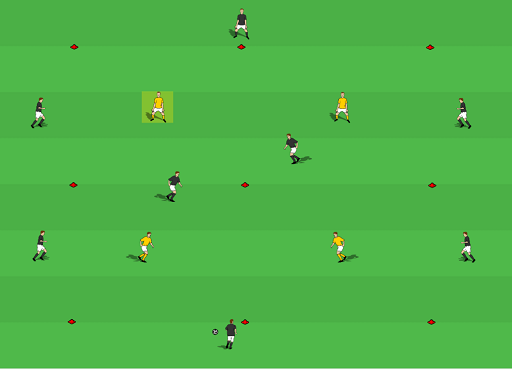
The position of the players mimics a 4-4-2 formation, minus one center back and one forward.
Black Team (Attackers): Maintain positions and possession of the ball with the emphasis on going forward from Centre Back to Forward (from the bottom of Diagram 1 to the top), rotating through the middle and utilizing passing options of support players, creating diamond and triangle shapes.
Diagram 2
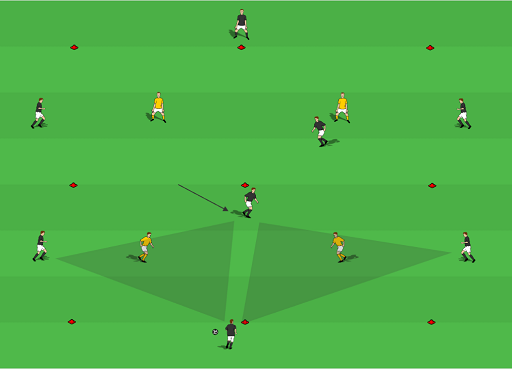
In diagram 2 above, one of the central midfielders drops into the hole between the two opposing forwards, creating two triangles of support for the ball. The outside players slide down off the shoulders of the defenders to give wide passing options,
Diagram 3
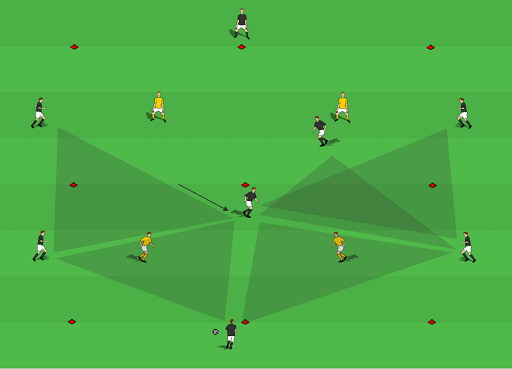
These players look to create passing options (triangles and diamonds) in wide areas to penetrate and advance forwards.
Diagram 4
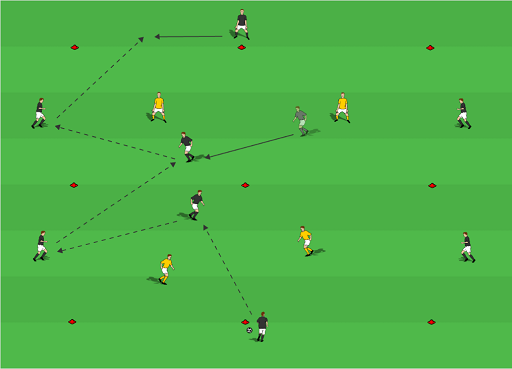
Yellow Team (Defenders): If possession is won, there are two options. Either play to the bottom player in black (center back) as quickly as possible, which replicates a counter attack in a game, or maintain possession 4 vs 2 in the central area (see below in Diagram 5. The center mids have to work hard in attack and then also work hard in defense to quickly win the ball back.
Diagram 5
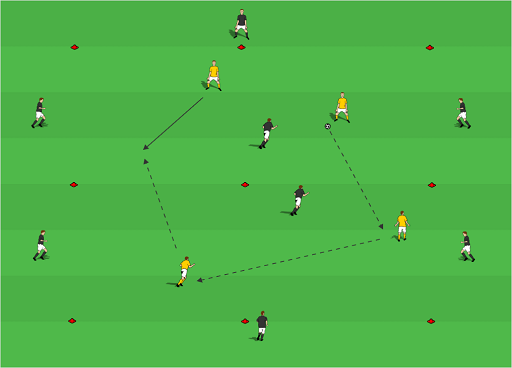
Competition: For the offense of 8, 10 passes is a point. If the defense steals the ball and manages to make 5 passes in the 4 v 2 in the middle, they score a point. Of course, you can adjust this number based on the age and skill level of your players.
Progression
When the attackers have success, add the condition that the defenders can move freely instead of staying in their rectangle.
Allow the wide “midfielder to go inside when the ball is in their half, also allowing the wide “fullbacks” to move up. Use rotation to create attacking overloads higher up the pitch, through overlapping and inverted runs.
Key Coaching Points
- Angles and distances between the wide players (simulating Full Backs and Wide Attackers) and Central Midfielders (game realistic)
- Quality, weight and decision of the pass (penetrate, play around or retain)
- Movement (Rotation) to receive and create diamond and triangle passing options
- Body shape to receive (taking the ball with the back foot)
- Angles, distances and combinations to penetrate effectively
- When to advance forwards and when to move inside
- Understanding slow and quick play through the areas
- Timing of passes
- Use the 3 passing lines (in front of defense, around defense & through defense) to create opportunities to penetrate
- Passing options around, behind and ahead of the ball
- Communication
By Gregg Gillies
Gregg Gillies is a nationally licensed coach through the USSF and is a Youth Athlete Development Specialist and Head Coach at Mount Laurel United Soccer Club, where he currently coaches a u14 girls team, the MLU Raptors. He also is the owner of www.NoLimitsSoccerTraining.com, where his focus is on maximizing a player's individual technical skills, soccer IQ, and overall athletic development.


